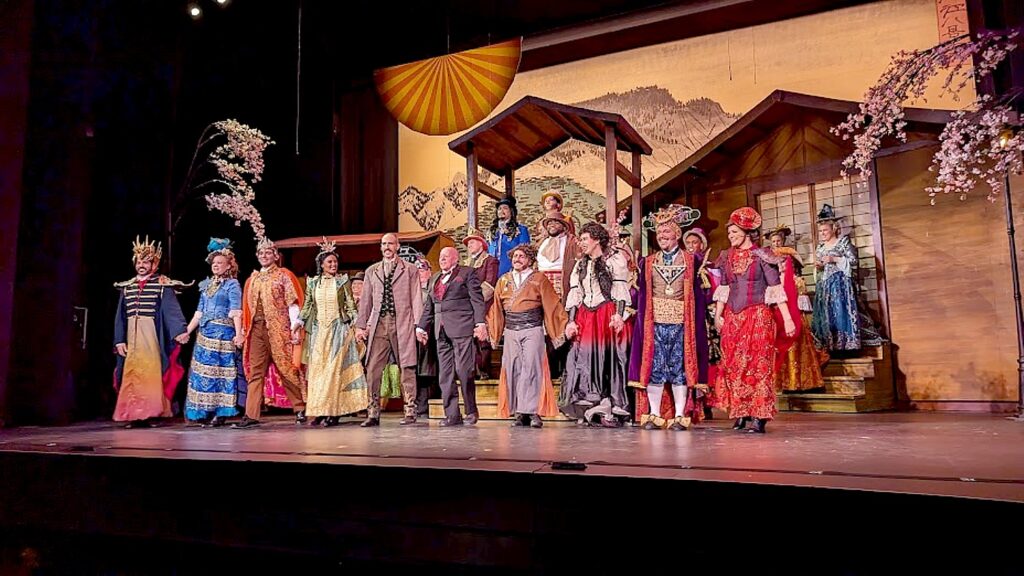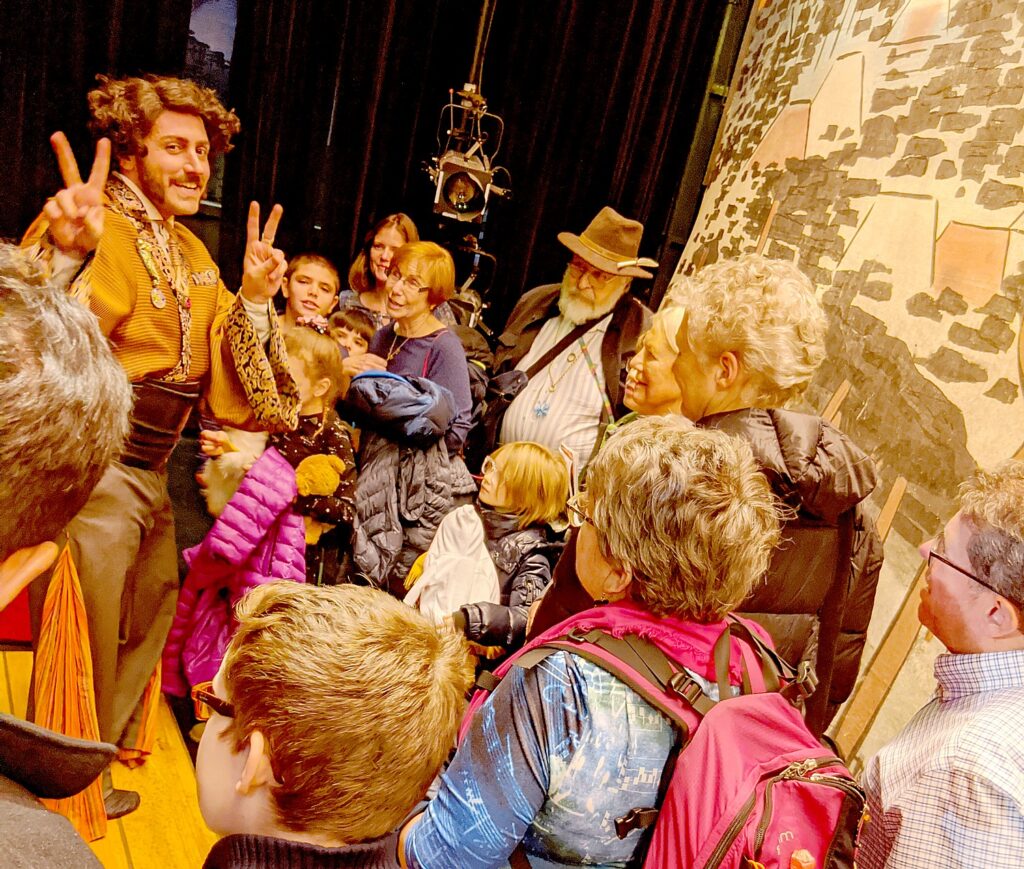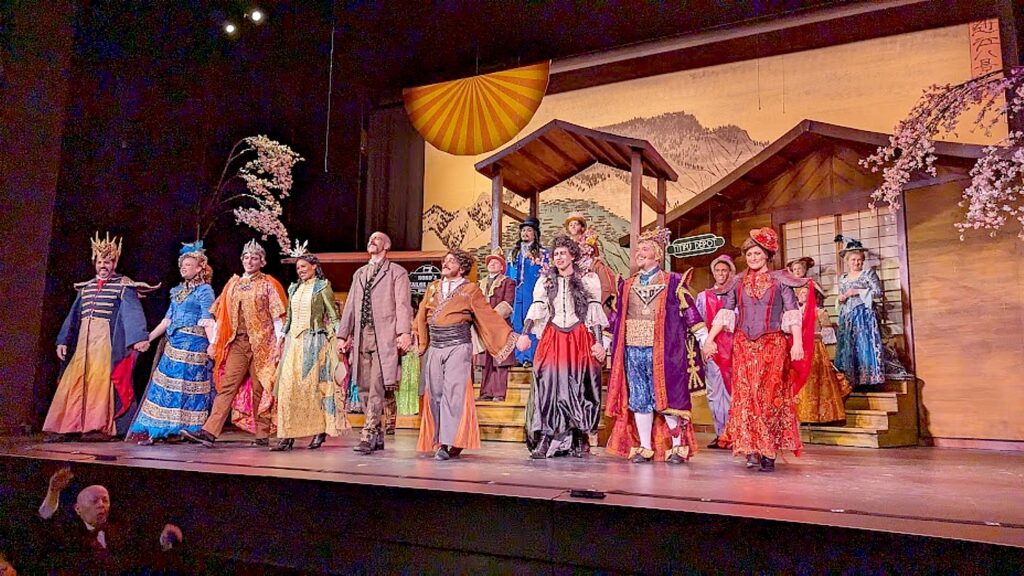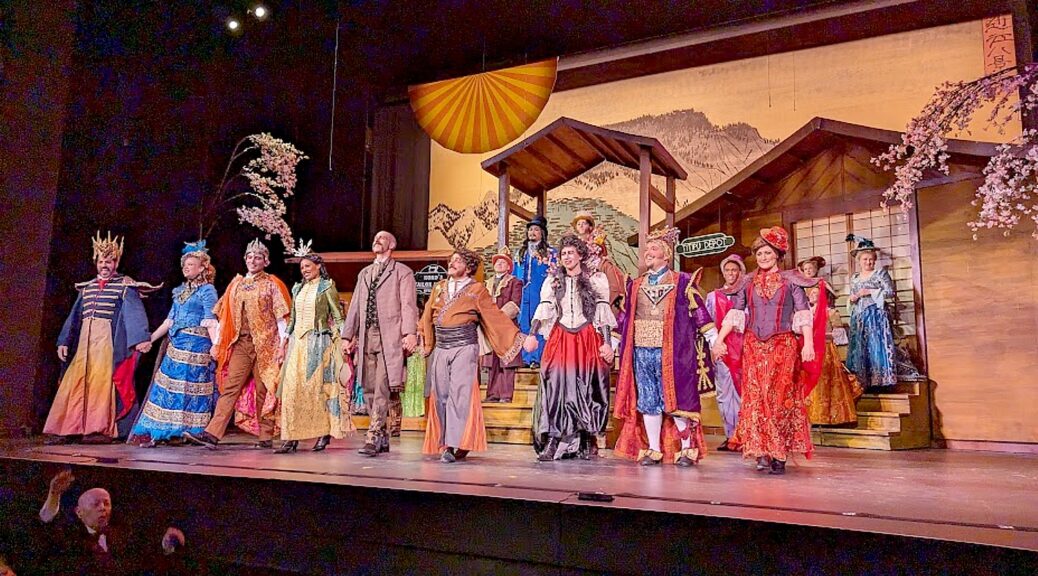
By Karen Rubin, Travel Features Syndicate, goingplacesfarandnear.com
The New York Gilbert & Sullivan Players company is one of New York City’s cultural treasures and fortunately, many outside the Big Apple will also have the opportunity to revel in the company’s artistry and talent as it finishes its stellar production of “The Mikado” and begins its annual road tour, this season featuring “The Pirates of Penzeance.”
Now in its 49th year, this extremely talented and creative company NYGASP, which is based out of the Kaye Playhouse at Hunter College, has been hailed as “the leading custodian of the G&S classics” and has created its own special niche in the cultural mosaic of New York City and the nation. NYGASP’s mission is “giving vitality to the living legacy of Gilbert & Sullivan,” says the company’s Founder/Artistic Director/General Manager Albert Bergeret.
Bergeret typically hosts a preview and introduction during a series, typically before a performance geared to families.
The new/ updated NYGASP production of The Mikado premiered in NYC in late 2016, features an original prologue that introduces the audience to the real life characters of the D’Oyly Carte Opera Company who originated The Mikado in 1885 London. The production centers the fantastic elements of juxtaposing a Victorian world with an imagined Japanese setting allowing the opera to be a truly inclusive experience for all audiences and artists.
The show abounds with absurdity and astounding wit, clever wordplay, memorable tunes and endearing characters, performed to perfection by clever patter man David Macaluso as Sullivan and Ko-Ko (who brings extraordinary physical comedy and a sweet voice); blustering Matthew Wages who plays Richard D’Oyly Carte and pompous Pooh-Bah; creative David Auxier as author Gilbert and town leader Pish-Tush (who also authored the new Prologue and is the director, and choreographer); charming John Charles McLaughlin as romantic hero Nanki-Poo, rising star Hannah Holmes as lovelorn and overbearing Katisha; beautiful soprano Rebecca L. Hargrove as self-aware Yum Yum; Sarah Hutchison as maiden sister Peep-Bo; mellifluous mezzo Elisabeth Cernadas as adventurous Pitti-Sing; and dynamic bass David Wannen in the title role.
The brilliant ensemble is rounded out by Caitlin Borek, Camilo Estrada, Chris-Ian Sanchez, James Mills, Katie Hall, Abby Kurth, Lance Olds, Logan Pitts, Maurio Hines, Michael Galante, Michelle Seipel, Sabrina Lopez, Viet Vo and Alexandra Imbrosci-Viera.
To their artistry and talent they exude a joy of performance.
The production showcases gorgeous scenery designed by Anshuman Bhatia, clever and inventive costumes by Quinto Ott and lighting by Benjamin Weill. The Mikado is produced by NYGASP Executive Director David Wannen. Founder and Artistic Director Albert Bergeret,sharing the podium with Associate Conductor, Joseph Rubin conducting the 25-piece orchestra.
NYGASP’s brilliant re-creation of Gilbert & Sullivan’s classic, “Mikado,” was first introduced in 2016, aimed at exorcizing the production of offensive stereotypes that might offend Asians that were embedded in the 1885 original. “It is a balancing act to respect the original but take out what people considered offensive,” Bergeret says.
A specially created “prologue” and creative costuming ensure there is no confusion that “Mikado” represents Englishmen satirizing Victorian society and politics, capitalizing on British fascination with all things Japanese in the 1880s, to defuse the pointed references that might have gotten Gilbert & Sullivan (already under censorship of Lord Chamberlain) into trouble. And frankly, the depiction of The Mikado (who doesn’t even appear for the first 2 ½ hours of the three-hour show) as a cruel but ridiculous tyrant is reminiscent of how the Red Queen is depicted in “Alice’s Adventures in Wonderland” (1865). If anything, the Mikado’s character may resonate in 2024 more than in 2015 or even 1885.
The clever Prologue. authored by the director, choreographer David Auxier-Loyala takes place on June 6, 1884 – one day after their “Princess Ida” opened, brings together D’Oyly Carte, the actual producer, with Arthur Sullivan, the composer and W.S. Gilbert, the lyricist and author (played by David Auxier), and has them talking about the Japanese exhibition that is all the stir in London. D’Oyly Carte is pushing them to come up with their next musical, and in their verbal interplay, these fanciful interjections become the fanciful names for characters – Pish-Tush, Pooh-Bah – and suggest plot points. Gilbert “dreams” the performance of “Mikado” – he becomes Pish-Tush, a Noble Lord; Sullivan becomes Ko-Ko, the Lord High Executioner, and D’Oyly Carte becomes Pooh-Bah (“the Lord High Everything Else”).
Of course British audiences of 1885 could have cared less about “political correctness.” The object of Gilbert & Sullivan’s satire was British society

We take advantage of seeing January 13 afternoon “Family performance”, which features a before-show talk introducing the plot and music presented by the esteemed Conductor and Musical Director Albert Bergeret, who founded the New York Gilbert & Sullivan Players 49 years ago (and was the original Nanki-Poo), I learn that my comparison of “Mikado” for Gilbert & Sullivan to “Madame Butterfly” by Puccini is not entirely unfounded. While the music that Sullivan composed runs the gamut of British musical styles (ballad, madrigal, march), he incorporates the Japanese five-note scale and an actual Japanese folk song, Miya-sama (though for this production, new English lyrics are substituted for the Japanese) – music which Puccini also appropriates in “Madame Butterfly.” (Miya-sama was not used in this production.)
“We took out what’s incomprehensible or inappropriate,” Bergeret says, who adds that Sullivan was a brilliant, classically trained musician who was well versed in all genres of music and composers from around the world. In “Mikado” Sullivan demonstrates his virtuosity in writing in many different forms.
Just as Gilbert incorporated contemporaneous digs, so too does this Ko-Ko, a “cheap tailor” (which means he made clothes for common people) taken from the county jail where he was scheduled to be executed (for flirting), and elevated to Lord High Executioner, update his “List” of those who shan’t be missed, to be as current as yesterday’s tweet, sometimes changing it each performance, surprising even the rest of the cast.

During our performance, Ko-Ko, brilliantly played by David Macaluso, who is not only brilliant at patter but physical comedy, inserts digs at A.I. and the “plagiarist” that got him on the list, and natural gas which somehow puts the “environmentalist” also on that long, long list as the scroll unfurls.
And The Mikado’s updated long list of who to punish and how, includes the Instagrammer “made to endure a dungeon cell without not one cellular bar” and “political pundits, who must sail for weeks on a boat full of leaks on a sea of alternative facts.” (That gets tremendous laughs.)
But Bergeret notes they do not want to do too much contemporizing. “We are proud to share this production, which upholds The Mikado’s musical score, setting, characters, storytelling, themes, and most of all its universal satire of human nature.”
So, the Mikado looks to execute Ko-Ko (the Lord High Executioner), Pooh-Bah (the “Lord High Everything” and Pitti-Sing (one of the “three little maids from school” for carrying out the Mikado’s orders to execute Somebody and unwittingly execute the Mikado’s son and heir to the throne, Nanki-Poo. The Mikado appreciates their effort (he only wishes he could have witnessed the execution) but insists they still should be executed for, well, killing the heir and looks for the entertainment value in their lingering death.
The Mikado justifies executing the three because, after all, this is an unfair world where the virtuous suffer and the undeserving succeed. This leads to the song that probably best sums up the moral of Gilbert & Sullivan’s “Mikado,” in which the three condemned sing, “See how the Fates their gifts allot/For A is happy, B is not/Yet B is worthy, I dare say/Of more prosperity than A…If I were Fortune which I’m not/B should enjoy A’s happy lot/And A should die in misery/That is, assuming I am B.”
In the end The Mikado is less a jab at all-powerful monarchal misrule, than a comic contemplation of what human beings do when in faced with existential situation. Their focus is on human nature and the human condition. In Mikado, we see self-preservation – even by Yum-Yum who is willing to marry Nanki-Poo who loves her so much he is willing to be executed after just a month, until she realizes that as the wife of an executed man, she would be buried alive.
This production makes another change at the end, stopping the show for a return to the Gilbert & Sullivan characters trying to figure out an ending that would not rely on a magical or fantastical device like the “magic lozenge” they used in their 1877 opera “The Sorcerer” and almost breaks up their collaboration. (Gilbert finally gets to use the device in “The Mountebanks,” written with Alfred Cellier in 1892). Instead, Gilbert comes up with an argument that actually makes sense given the circumstance: Any order by the Mikado must be carried out, so having given the order, it must have been carried out (not much more absurd than “Anything the President does is legal and immune from prosecution, even if he orders Seal 6 to kill his political opponent.”).

“The Mikado, or The Town of Titipu” – the ninth of Gilbert & Sullivan’s 14 collaborations – was immensely popular when it opened on March 14 1885 in London, running for 672 performances, the second longest run for any musical theater production. By the end of 1885, some 150 companies in Europe and America were performing the operetta. It even was widely performed in Japan (apparently they took no offense).
Indeed, “The Mikado” is one of the most popular productions of musical theater of all time. Performed for the last 135 years – by the D’Oyly Carte Opera Company, NYGASP and others including Joseph Papp’s Shakespeare in the Park festival – there were decades when “Mikado” was being performed somewhere in the English speaking world any day of the year. Some of its word inventions have entered the lexicon, such as “the grand Poo-Bah” and “Let the punishment fit the crime.” They have also been performed in languages including Yiddish and French, though Bergeret notes that the French don’t seem to get the jokes.
G&S were very popular in their own time – all their 14 shows were popular and “Mikado” was one of most popular written out of their 14 (one, “Thespis,” was lost). Their nods to classical and digs at British society and conventions and their union of witty lyrics and lyrical music, appealed to high and low class. Both wrote with others but were never so successful as when they collaborated together. “They were very different characters – Sullivan was a lady’s man” – aspects that come through in the specially written “Prologue” to Mikado.
“The only one who doesn’t like Gilbert was Queen Victoria, Bergeret tells us. “We are not amused,” Queen Victoria once commented. The Queen knighted Sullivan as the “savior of English classical music.” (Her son, King Edward VII, knighted Gilbert.)
Gilbert & Sullivan actually invented musical theater. At the time Gilbert & Sullivan were writing, there were opera, light opera and music hall theatricals, but nothing like a musical show with story – music that had both class and pop – with real story lines, music advanced the story, Bergeret tells us. This is where musical theater started,. Watching “Mikado” you see a straight line to Rogers & Hammerstein and Stephen Sondheim.
Since its founding in 1974, the company has presented over 3,000 performances of the G&S masterpieces throughout the United States, Canada, and the U.K. delighting audiences of all ages.
The company’s celebrated ensemble of G&S experts, developed by introducing new singers each year from New York’s immense pool of vocal and theatrical talent, has collaborated with such guest artists as world-renowned G&S exponent the late John Reed, O.B.E. in numerous comic baritone roles, Tony winner John Rubinstein and Frank Gorshin both as King Gama in Princess Ida, John Astin as Sir Joseph in H.M.S. Pinafore, Hal Linden and Noel Harrison as the Major General in The Pirates of Penzance, Pat Carroll as Little Buttercup in H.M.S. Pinafore, and Steve Allen as The Mikado.
The company’s repertory consists of 13 complete G&S operas (cast, orchestra and crew of 50-80 people), special versions of the most popular operas designed for children’s audiences, and a variety of charming sextet concert programs. The company has also produced a cabaret act. I’ve Got a Little Twist, created and directed by David Auxier, won a 2010 Bistro Award, has toured the country and appeared at Lincoln Center’s 2011 Atrium series.
NYGASP Founder/Artistic Director/General Manager, Albert Bergeret is a career-long professional specialist in the works of Gilbert & Sullivan, having performed, staged, conducted and designed every opera in the repertoire since the company’s founding in 1974. He has conducted and staged all 13 of the works in the G&S canon as well as the company’s smash hit production of George Gershwin’s Of Thee I Sing.
New York Gilbert & Sullivan Players are worthy of a Tony Award.
Coming up, NYGASP will present G&S’s “The Sorcerer” and “Trial by Jury” on April 6-7.
Also, NYGASP regularly tours its shows, and this year is featuring “Pirates of Penzance”:
Feb. 28: An Evening of G&S Favorites, Lincoln Center, Fort Collins, CO
Feb. 29: The Pirates of Penzance in One Act/Evening of G&S Favorites, Lone Tree Arts Center, Lone Tree, CO
Mar. 3, 2024, The Pirates of Penzance, Popejoy Hall, Albuquerque, NM
Mar. 5: The Pirates of Penzance, Mesa Arts Center, Mesa, AZ
Mar. 7: The Pirates of Penzance, Gallo Center for the Arts, Modesto, CA
Mar. 8: The Pirates of Penzance, Clark Center for the Performing Art, Arroyo Grande, CA
Mar. 9: The Pirates of Penzance, Torrance Cultural Arts Center, Torrance, CA
Mar. 10: The Pirates of Penzance, McCallum Theatre, Palm Desert, CA
Apr. 26: The Pirates of Penzance in One Act/Evening of G&S Favorites, Harry M. Cornell Arts & Entertainment Complex, Joplin, MO
May 10: The Pirates of Penzance, Mayo Performing Arts Center, Morristown, NJ
More information at www.NYGASP.org, 212-772-4448.
____________________________
© 2024 Travel Features Syndicate, a division of Workstyles, Inc. All rights reserved. Visit goingplacesfarandnear.com and travelwritersmagazine.com/TravelFeaturesSyndicate/. Blogging at goingplacesnearandfar.wordpress.com and moralcompasstravel.info. Visit instagram.com/going_places_far_and_near and instagram.com/bigbackpacktraveler/ Send comments or questions to FamTravLtr@aol.com. Tweet @TravelFeatures. ‘Like’ us at facebook.com/NewsPhotoFeatures

